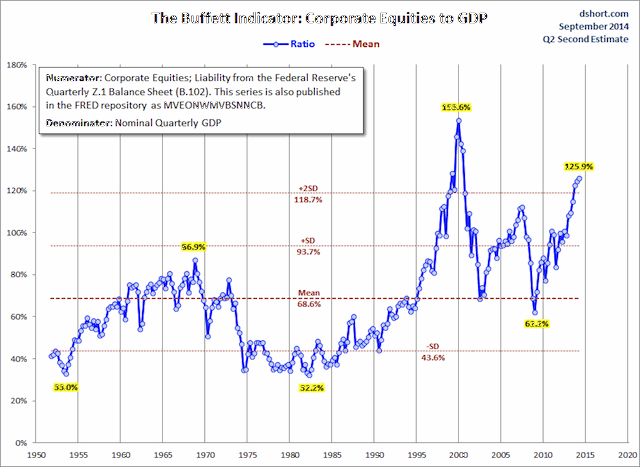The percent of total market cap relative to Gross National Product
Post on: 16 Март, 2015 No Comment

Market Overvalued, How to Invest?
Stay defensive! GuruFocus Buffett-Munger Screener is the screen for high quality companies at undervalued prices. The portfolio of Buffett-Munger companies has outperformed the market every year.
The Predicted and the Actual Stock Market Returns
What returns can we expect from the stock market?
As of today, the Total Market Index is at $ 21869.6 billion. which is about 123.5% of the last reported GDP. The US stock market is positioned for an average annualized return of 0.3%. estimated from the historical valuations of the stock market. This includes the returns from the dividends, currently yielding at 2%.
As pointed by Warren Buffett. the percentage of total market cap (TMC) relative to the US GNP is probably the best single measure of where valuations stand at any given moment.
Over the long term, the returns from stock market are determined by these factors:
1. Interest rate
Interest rates act on financial valuations the way gravity acts on matter: The higher the rate, the greater the downward pull. That’s because the rates of return that investors need from any kind of investment are directly tied to the risk-free rate that they can earn from government securities. So if the government rate rises, the prices of all other investments must adjust downward, to a level that brings their expected rates of return into line. Conversely, if government interest rates fall, the move pushes the prices of all other investments upward.Warren Buffett
2. Long Term Growth of Corporate Profitability

Over the long term, corporate profitability reverts to its long term-trend, which is around 6%. During recessions, corporate profit margins shrink, and during economic growth periods, corporate profit margins expand. However, long-term growth of corporate profitability is close to long-term economic growth. The size of the US economy is measured by Gross National Product (GNP). Although GNP is different from GDP (gross domestic product ), the two numbers have always been within 1% of each other. For the purpose of calculation, GDP is used here. The U.S. GDP since 1970 is represented by the green line in the first of the three charts to the right.
3. Market Valuations
Over the long run, stock market valuation reverts to its mean. A higher current valuation certainly correlates with lower long-term returns in the future. On the other hand, a lower current valuation level correlates with a higher long-term return. The total market valuation is measured by the ratio of total market cap (TMC) to GNP — the equation representing Warren Buffett’s best single measure. This ratio since 1970 is shown in the second chart to the right. Gurufocus.com calculates and updates this ratio daily. As of 03/12/2015. this ratio is 123.5% .
We can see that, during the past four decades, the TMC/GNP ratio has varied within a very wide range. The lowest point was about 35% in the previous deep recession of 1982, while the highest point was 148% during the tech bubble in 2000. The market went from extremely undervalued in 1982 to extremely overvalued in 2000.
Based on these historical valuations, we have divided market valuation into five zones:














